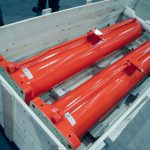Apex Hydraulics were approached by a plant hire company that specialises in the rental of telescopic handlers and related equipment. The company were finding that their JCB 535-140 and JCB 540-170 telescopic handlers were not performing with the longevity required of them due to premature hydraulic cylinder failure. They commissioned Apex to produce a design modification that would increase the lifespan of the vehicle without the need to buy new cylinders.
Telescopic Handlers
Telescopic handlers (also known as telehandlers) are capable of extending pallet arms (or one of various other attachments) out on a long boom while carrying a load, allowing the telehandler to move goods from place to place with more flexibility than a forklift truck. Essentially it combines the benefits of a forklift and a crane in one machine.
However, as the boom extends to its full length, additional pressure is put on the machinery, producing a lever action. Because of this, the load that can be safely carried with the boom fully extended is dramatically reduced, when compared to the amount that can be carried when the boom is retracted into the body of the machine.
With careful use and a calculation of the reduced weight that is safe to carry on a fully extended load, the machinery can be preserved and kept free from damage. However, as is often the case with rented machinery, the telehandlers were being used to their full capacity (and perhaps, on occasion, beyond their limits).
The problem
The telehandler hire company was finding that the machines had a mere 1000 hours of use before developing a fatal flaw. With telehandlers regularly returning requiring repairs, there was a direct impact on the business profit.
The cylinder repairs from the Original Equipment Manufacturer (OEM) were failing, once again at around the 1000-hour mark, suggesting that the parts were subjected to higher loads and fatigue beyond their capacity. While the vehicle was developed to work at the recommended limits, there was no over engineering to account for the harsher working conditions hire vehicles are often exposed to; larger weights being over extended, sudden braking, or erratic driving. This is a common issue for OEMs developing hydraulics across a huge fleet of vehicles. When making thousands of cylinders at a time, the priorities will be in making the equipment light-weight, with as little material as possible and cost effective – when competing on price with other companies, there is no scope for spending money on over-engineering parts of the equipment.
Unwilling to continue to soak up the costs of repeated replacement cylinder rods, the client decided to leave the OEM and approached Apex, to see if we could repair the cylinders with parts that would be more durable and could withstand the harsh working environments that they were exposed to, giving them a longer working life.
Apex Solution
Initially the failed cylinder was brought to the specialist strip and assessment area of the workshop. The parts were stripped and examined in order to identify the cause of the fault. Apex found that the piston rods, responsible for the extension and retraction of the boom, were bending. This was causing a number of problems including damaged seals and rod coating, which was contaminating the hydraulic fluidand leading to complete cylinder failure. Design engineers worked to develop a new design that would be more resistant to the loads put on the rod. The easiest solution would have been to make a hydraulic rod with a larger diameter, but there were strict parameters, in that the rod was already as large as possible within the space limitations. However, the material was improved to be a higher strength steel which was induction hardened and chrome plated. A complete redesign of the neck gland, piston and seal arrangements meant that the rod could withstand some slight bend, essentially “bouncing back” after strain. With the increased surface hardness of the rod, it was less likely to scrape or gore in the event of a bend, meaning that seals and the cylinder as a whole would not be damaged.
Apex produced a design for the client, visually depicting the improvements they planned to make. Once approved, the repairs were produced in the machine shop, and installed in the fitting department, all by Apex’ qualified and skilled machine engineers. After initial testing in the dedicated inspection department, the repaired hydraulics were fitted back into the telehandlers, and marked, to identify the repaired hydraulics and assess their performance in comparison to the performance of the non-repaired hydraulics.
Apex has initially produced hydraulic repairs on 30 machines. The first vehicles are already well past the 2000-hour mark and are still working well. More repairs are commissioned.
The Results
Some of the repaired cylinders have been on the telehandlers for over a year; already at least doubling the lifespan of the telehandlers. There have not yet been any recorded hydraulic cylinder failures with the repaired design, so the full extent of the repair benefits is yet to be quantified. However, this first year has evidenced that the improved design of the rod has preserved the life of the hydraulic cylinders considerably. This will save the company money both in parts and labour and in reducing the amount of downtime for each telehandler.
Gallery
Please find related images below…
Related Products
The following products were utilised as part of this project. For more detailed information on these products, click on an image below…







